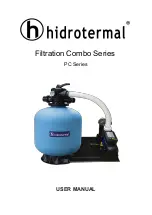
6 Test Procedures
6.1 Introduction
WARNING
Electrical Hazard!
Touching electrical parts of the filter may be fatal even
after equipment has been disconnected from AC power.
Wait 20 minutes for D-frame sizes, 30 minutes for E-frame
sizes after power has been removed before touching any
internal components to ensure that capacitors have fully
discharged. See label on front of filter door for specific
discharge time.
This section contains detailed procedures for testing filters.
Previous sections of this manual provide symptoms,
alarms, and other conditions which require additional test
procedures to further diagnose the filter. The results of
these tests indicate the appropriate repair actions. Again,
because the filter monitors input and external signals, the
source of fault conditions may exist outside of the filter
itself. Testing described here isolates many of these
conditions as well. The Disassembly and Assembly
Instructions describe detailed procedures for removing and
replacing filter components.
Filter testing is divided into
Static Tests
,
Dynamic Tests
, and
After Repair Tests
. Static tests are conducted without power
applied to the filter. Most filter problems can be diagnosed
simply with these tests. Static tests are performed with
little or no disassembly. The purpose of static testing is to
check for shorted power components or faulty
connections. Perform these tests on any unit suspected of
containing faulty power components before applying
power.
CAUTION
For dynamic test procedures, main input power is required.
All devices and power supplies connected to line power
are energized at rated voltage. Use extreme caution when
conducting tests on a powered filter. Contact with
powered components could result in electrical shock and
personal injury.
Dynamic tests are performed with power applied to the
filter. Dynamic tests are performed with power applied to
the adjustable frequency drive.
Replace any defective component and retest the filter with
the new component before applying power to the filter as
described in
After Repair Drive Tests
.
CAUTION
Line Power (Primary Side) Current
Use a shorting connector on the secondary side of
customer-supplied external current transformers (CT)
whenever current is present on line power (primary side)
and the AFC card is NOT wired to the external CT
terminals. When performing service on an active filter, use
a shorting connector on the secondary side of external CTs
for extra safety. Failure to short out the secondary side of
current transformers when current is present on the
primary side and the AFC card is NOT connected could
damage the current transformer.
SB-ME 8
130BX359.10
1
2
Figure 6.1 Shorting Connector
1
Shorting lug
2
Shorting connector
Table 6.1
Shorting Connector
A shorting connector must be placed on the secondary
side of customer-supplied external CTs whenever current is
present on line power and the AFC card is NOT wired to
the external CT terminals. Failure to short out the
secondary side of the CT could damage the CT.
The AFC card provides the step-down current
function when connected
When the AFC card is not connected, the
secondary side must be shorted
Test Procedures
VLT Advanced Active Filter AAF006 D and E Frames Service Manual
MG90Z122 - VLT
®
is a registered Danfoss trademark
6-1
6
6
















































